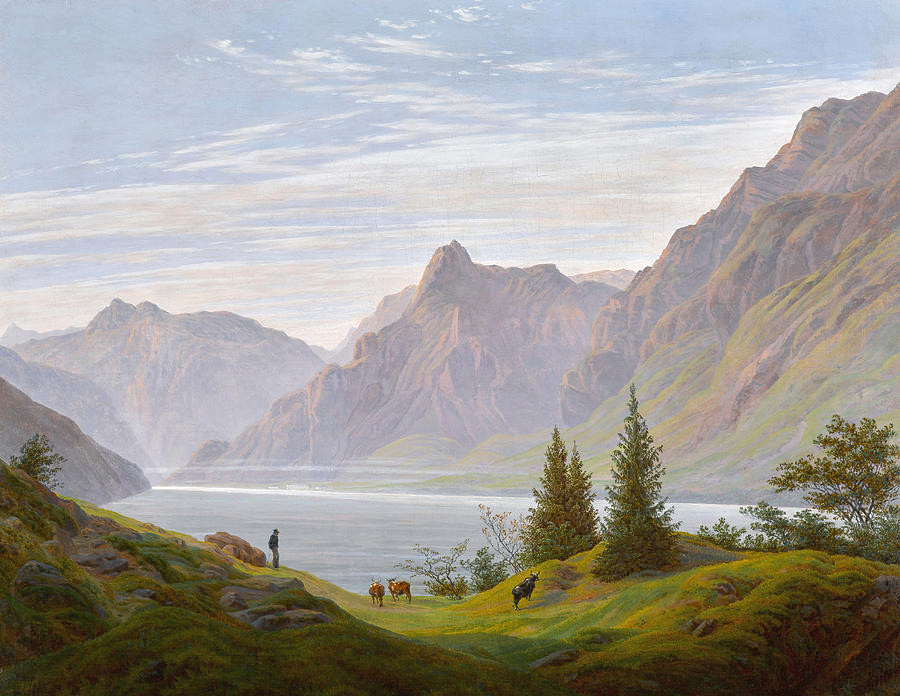The queue outside Berlin’s old national gallery starts at its steps, snakes through the courtyard on the Museum Island, continues down the colonnade of pillars pockmarked by Red Army bullets and ends, 300m later, at the Spree river.
People have been waiting close to four hours in 30 degree heat, through four seasons of wind, sun and torrential rain. Most have no umbrellas to shield them and are wet, hot and happy. “I was here yesterday but just had to come back, it’s magical,” says Ralph, a 52-year-old local, on the last day of Berlin’s retrospective of Caspar David Friedrich.
For many here the landscape painter is the dead white male equivalent of Taylor Swift. The two artists spark a staggering devotion and emotional overload in their respective army of admirers. And these people, in turn, truck no criticism of their idol.
As Swifties have followed their high priestess of pop around Europe this summer, acolytes of CDF, as they call him, have been on a pilgrimage of their own. First in Hamburg, then Berlin and soon in Dresden – a megashow marking Friedrich’s 250th birthday has been a runaway success by tapping into an often-ignored German personality trait. Long before Germany became the country of engineers and techno this was a big European homeland for stare-at-the-moon-and-sigh romantics.
In the early 19th century of Friedrich’s youth, Germany was still a collection of kingdoms, and growing industrialisation was drawing people from the countryside into the cities. While others embraced this shift towards rationality, enlightenment thinking and the idea of nationhood, Friedrich looked the other way.
The son of a craftsman from the northeastern city of Greifswald, then under Swedish rule, Friedrich struck out on his own across the deserted landscapes and chalky cliffs of his native western Pomerania and the island of Rügen.
Dismissed by many non-Germans as fridge magnet kitsch, German fans insist the best way to tap into the Friedrich feeling is to follow the gaze of figures in his paintings, often with their back to the viewer, as they take in various wonders of nature: a misty peak, a crescent moon.
His popular works in Berlin are clearly the darker and mystical works: an evening funeral before the hulking Gothic ruins of a Cistercian abbey or a man with a walking stick atop a peak, staring into a misty landscape.
Inspired by real, Saxon peaks, Friedrich filled his images with allegories and metaphors – most often to evoke religious feeling in the viewer.
Friedrich was a man of deep faith, shaped by northern German Lutheran Christianity. Experts see in many images a divine light at the end of the path of life, hope of the resurrection and eternal life. For the painter such longing was personal and painful: when he was 13 Friedrich got into difficulty swimming and was saved by his 12 year-old brother, who drowned in the process.
Even Friedrich’s most popular landscapes, often two-thirds sky, were more than just studies of trees and hills. His wife Caroline warned a friend: “You mustn’t disturb him when he is painting the sky, for him it is like a church service.”
The title of the show – Infinite Landscapes – is a nod to Friedrich Schleiermacher, a German theologian whose writings on faith influenced Friedrich deeply. “Religion is not what a religious community teaches in terms of doctrines and morals, but is felt personally,” wrote Schleiermacher. “Religion becomes an individual religious experience, a ‘sense and taste for infinity’.”
Friedrich explored his faith through the infinity of nature, which he saw as God’s creation, and described his artistic practice as being “like a pious man who prays without a word”.
“The empathetic painter paints,” wrote Friedrich, “and the empathetic viewer understands.”
Not all viewers understood this and after his death in 1840 Friedrich’s work fell into obscurity. Revived in the early 20th century, it was soon co-opted by the Nazis as a fascist visual shorthand of an ideal Germany alongside the music of Wagner and the philosophy of Nietzsche.
A century on, the painter is big box office. While some 440,000 Swifties turned out for seven sold-out German Eras concerts, the long-dead Friedrich has sold 635,000 tickets so far. Dresden hopes to welcome the millionth visitor on the third leg of the painter’s tour.
In another anxious age of rising far-right nationalism, the paintings of Caspar David Friedrich offer a calming balm for the anxious German soul.
The Rediscovery of a Romantic Master
On the occasion of the 250th anniversary of the birth of Caspar David Friedrich, the most important painter of German Romanticism, the Old National Gallery in Berlin is hosting a selection of more than sixty paintings and more than fifty drawings by the artist that reflect on the situation of human beings in relation to the world.
A Delicate Representation of Nature's Boundless Meaning
With unusual delicacy, the artist creates representations of the boundless meaning of nature, of longing and hope, a sample of the sensitivity and depth of the painter, celebrated as an outstanding painter of atmospheres and as a pioneer of modernism.
Exploring the Landscapes of a Romantic Master
The exhibition on the work of the German artist Caspar David Friedrich (1774-1840) takes place at the Alte Nationalgalerie in Berlin from April 9 to August 4, 2024, where you can still visit world-famous emblematic works such as "The Sea of Ice", "Chalk Cliffs on Rügen" or "The Stages of Life".
Friedrich's representations are contextualized in the ideology of the enlightened man of the late 18th century and throughout the 19th century, an ideology where looking at nature becomes the centre of new currents of thought, as a reference for freedom with new systems of life and government, compared to those of the old regime. His paintings delve into the meaning of nature, which goes beyond the visible, whose value can be felt but can hardly be expressed in words. In the artist's works we can observe a hint of questions about human life and its finitude.
A Legacy of Inspiration
The rediscovery of Caspar David Friedrich's work in the 20th century has sparked a renewed interest in his life and art, inspiring travelers to explore the landscapes he so beautifully captured in his paintings. His art, imbued with a sense of wonder and mystery, invites us to contemplate our place in the natural world. The paintings of Caspar David Friedrich continue to hold a powerful appeal, reflecting not only the beauty of the natural world but also the enduring human longing for a sense of transcendence.
The exhibition in Berlin is a testament to the enduring legacy of Caspar David Friedrich. It offers visitors the opportunity to engage with the artist's work on a personal level, immersing themselves in the landscapes that inspired him and exploring the themes of nature, faith, and human existence that permeate his art. As Friedrich himself wrote, "The empathetic painter paints, and the empathetic viewer understands." And in this age of increasing anxiety and uncertainty, the quiet beauty and profound insights of Caspar David Friedrich's paintings offer a much-needed dose of inspiration and solace.
Following in Friedrich's Footsteps
For those seeking to follow in the footsteps of Caspar David Friedrich, a pilgrimage to the landscapes that inspired him is an unforgettable experience. From the Baltic coast to the Elbe Sandstone Mountains, the regions he frequented are rich in natural beauty and historical significance. This pilgrimage offers a chance to connect with nature, to appreciate the art of Caspar David Friedrich on a deeper level, and to find a sense of peace and perspective in the face of the modern world. As the artist once said, "The sky is a mirror of our souls." By exploring the landscapes that inspired Caspar David Friedrich, we can gain a better understanding of both the natural world and our own inner selves.
A Lasting Legacy
Caspar David Friedrich’s work continues to be relevant and inspiring to this day. His paintings offer a timeless perspective on the human condition, exploring the relationship between humanity and nature, faith and doubt, and the search for meaning in a complex world. As we navigate an increasingly uncertain world, the art of Caspar David Friedrich provides a powerful reminder of the enduring beauty and mystery of the natural world, and the importance of seeking solace and inspiration in the face of adversity.

















